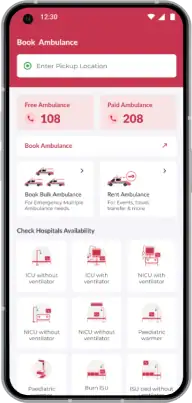In the realm of emergency medical services (EMS), swift and effective care can make the difference between life and death. Two key components of this care are Basic Life Support (BLS) and Advanced Life Support (ALS), both crucial in providing the appropriate level of care based on the severity of the situation. In this article, we will delve into the difference between BLS and ALS, exploring their roles, equipment and the critical distinction they bring to medical emergencies.
Basic Life Support (BLS):
BLS Ambulance Full Form: Basic Life Support Ambulance
Role and Scope:
BLS is the foundational level of medical care provided by trained medical professionals and first responders in emergency situations. It primarily focuses on immediate interventions to sustain life and provide assistance until further medical help arrives. BLS ambulance is designed to address relatively straightforward medical emergencies that do not require complex interventions.
Key Functions:
- Cardiopulmonary Resuscitation (CPR): BLS providers are skilled in performing CPR, a life-saving technique that involves chest compressions and rescue breaths to maintain blood circulation and oxygenation.
- Airway Management: Basic airway management techniques, such as using simple airway adjuncts and maintaining a clear airway, are part of BLS training.
- Automated External Defibrillation (AED): BLS-trained individuals can use an AED to deliver an electric shock to restore normal heart rhythm in cases of sudden cardiac arrest.
- Control of Bleeding: BLS responders are trained to control external bleeding and manage shock through basic wound care and stabilization.
BLS Ambulance Equipment List:
- Bag Valve Mask (BVM): A device used for manual ventilation of a patient's lungs.
- AED: Automated External Defibrillator for restoring normal heart rhythm.
- CPR Mask: A mask used during CPR to provide a barrier between the rescuer and the patient.
- Bandages and Dressings: For controlling bleeding and wound management.
- Oxygen Delivery Devices: Basic oxygen masks and nasal cannulas for supplemental oxygen administration.
- First Aid Supplies: Various supplies for basic wound care and support.
Advanced Life Support (ALS):
ALS Ambulance Full Form: Advanced Life Support Ambulance
Role and Scope:
ALS goes beyond the foundational interventions of BLS and involves a higher level of medical training and equipment. ALS providers are trained to manage more complex medical emergencies, including those that require interventions such as medication administration, advanced airway management and more in-depth monitoring.
Key Functions:
- Advanced Airway Management: ALS providers are skilled in advanced airway techniques, such as endotracheal intubation and the use of supraglottic airway devices.
- Medication Administration: ALS providers can administer a range of medications, including pain management, cardiac medications and more.
- Cardiac Monitoring: ALS ambulances are equipped with cardiac monitors that allow for continuous monitoring of a patient's heart rhythm and vital signs.
- Intravenous Access: ALS providers can establish and manage intravenous (IV) lines to administer fluids and medications.
- Advanced Diagnostic Skills: ALS providers have the training to conduct more thorough assessments and diagnostics to determine appropriate treatment.
ALS Ambulance Equipment List:
- Cardiac Monitor/Defibrillator: Monitors heart rhythm and can deliver electrical shocks when needed.
- Advanced Airway Devices: Intubation equipment, supraglottic airway devices and tools for managing complex airway issues.
- Medications: A variety of medications for pain management, cardiac issues and other medical conditions.
- Intravenous Supplies: Equipment for establishing and managing IV lines.
- Ventilator: A device that assists with breathing and provides positive pressure ventilation.
- Pulse Oximeter: Measures oxygen saturation in the blood.
- Advanced Diagnostics Tools: Equipment for performing more comprehensive assessments and diagnostics.
Conclusion:
In the world of emergency medical services, both Basic Life Support (BLS ambulance) and Advanced Life Support (ALS ambulance) play pivotal roles in saving lives. BLS ambulance focuses on immediate interventions to sustain life in straightforward emergencies, while ALS ambulance brings a higher level of training, equipment and interventions to manage complex medical situations. Each level serves a crucial purpose in the constant care, ensuring that individuals in need receive the appropriate level of support until they can receive definitive medical treatment.
Understanding the difference between BLS and ALS is essential for both medical professionals and the general public. It empowers individuals to make informed decisions during emergencies and reinforces the critical nature of trained responders in ensuring the best possible outcomes for patients in their time of need.






